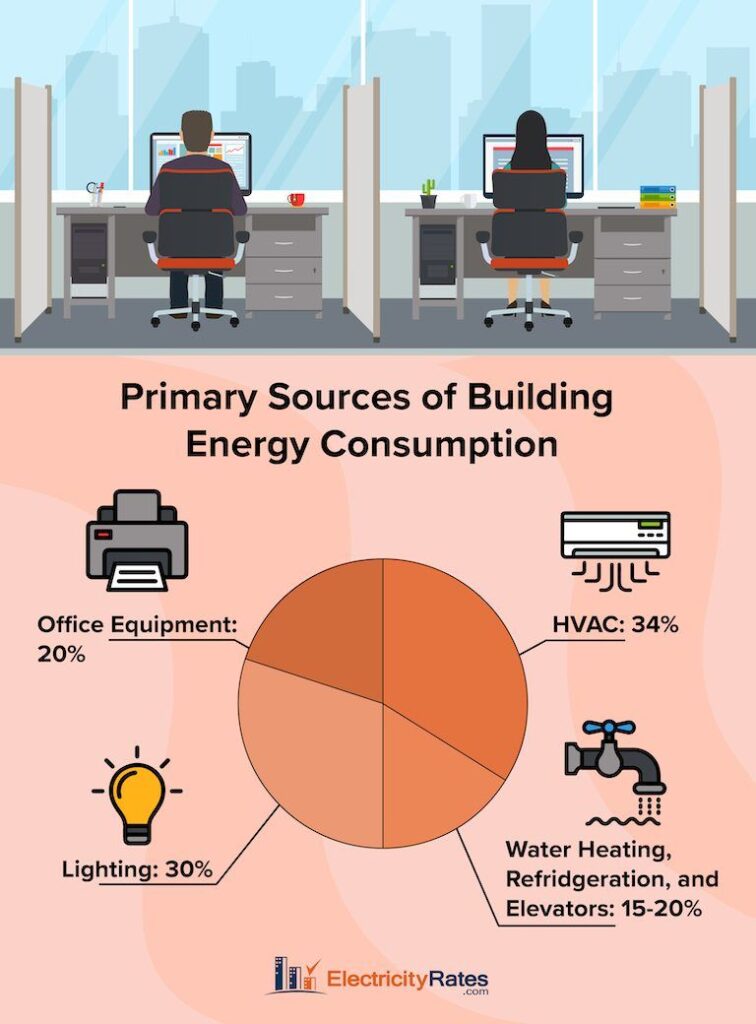The browser you are using is not supported. Please consider using a modern browser.

Your Guide To Saving On Commercial Building Energy Use
Table of Contents

Commercial buildings are energy hogs, accounting for over 18% of total U.S. electricity consumption. Each year, business owners spend over $190 billion on energy.
With power costs rising, facility managers and owners are desperate for ways to curb energy waste. This beginner’s guide breaks down the major sources of energy use in commercial buildings and provides steps for evaluating your energy efficiency opportunities.
We’ll also highlight how ElectricityRates.com can help you manage energy costs by comparing power providers and plans. With the right information and resources, you can take control of your building’s energy expenses.
Primary Sources of Building Energy Consumption
Below is the typical commercial building energy use breakdown. Lighting, HVAC, and office equipment comprise the bulk of energy use in commercial buildings.

- Lighting – Accounts for 30% of average commercial building energy consumption.
- HVAC (heating, ventilation, air conditioning) – HVAC energy consumption in commercial buildings averages 34% of total energy use. This includes boilers, furnaces, air conditioning units, pumps, and fans.
- Office Equipment – Computers, monitors, printers, and appliances make up approximately 20% of average energy use.
- Other – The remaining 15-20% goes to water heating, refrigeration, cooking, and elevators.
To start reducing energy consumption, conduct a commercial building energy audit. Focus on lighting and HVAC first, as these tend to offer the most significant savings.
Consider upgrades like:
- LED bulbs
- Occupancy sensors
- High-efficiency HVAC equipment
- Improved insulation
- Smart thermostat optimization
Comparing electricity rates and providers can also help manage costs. ElectricityRates.com makes it easy to compare rates and plans to find the most competitive commercial electricity pricing.
HVAC Systems are a Major Energy Consumer
As mentioned above, HVAC stands for heating, ventilation, and air conditioning. It includes all equipment involved in heating and cooling, such as boilers, furnaces, air conditioning units, pumps, fans, and ductwork.
On average, HVAC accounts for 34% of energy consumption in commercial buildings. This is the single largest portion of energy use. The exact percentage varies by building type – for example, HVAC represents 33% of energy use in office buildings, 38% in education facilities, and up to 44% in hospitals.
There are several reasons why HVAC drives high energy consumption:
- Heating and cooling demands fluctuate dramatically by season and even time of day. This requires constant adjustment by HVAC systems.
- Much energy is lost through distribution systems like ductwork or via envelope leakage. Estimates range from 15-30% of HVAC energy waste.
- Older HVAC equipment operates less efficiently than today’s models. Units degrade over time as well.
- Improper HVAC sizing leads to inefficient operation—oversized units cycle on/off frequently, while undersized units run almost constantly.
- The lack of smart controls like programmable thermostats adds to inefficient runtime.
Upgrading HVAC equipment, adding smart controls, improving insulation, sealing leaks, and optimizing maintenance practices offer significant energy-saving opportunities for commercial buildings.
ElectricityRates.com provides custom quotes to compare rates and power providers, helping businesses save on high HVAC energy bills.
Average Energy Use by Building Type
If you’re wondering how much energy a commercial building uses, here’s the breakdown.
Industrial buildings have the highest energy use intensity, averaging around 150 kBtu per square foot annually. Major end uses include manufacturing equipment, HVAC for ventilation needs, and high-intensity lighting.
Retail buildings have an average EUI of around 80 kBtu per square foot per year. Lighting is particularly intensive for visual merchandising, and HVAC must provide comfort for customers.
Offices have a lower average EUI of around 65 kBtu per square foot annually. However, they account for the greatest total commercial square footage and, thus, large aggregate energy use. Data centers located within office spaces also have very high energy demands.
Understanding the energy your building uses and how it compares to the national median can provide insight into efficiency opportunities.
Upgrading older, inefficient building systems can reduce energy waste and lower operating costs. Comparing commercial electricity rates is another way to save, and ElectricityRates.com provides free quotes to help businesses find the best electric plans.
For powerful ways to increase energy efficiency in commercial buildings, perform a commercial building energy audit, and save, see our articles here.
Save on Your Commercial Energy Bills with ElectricityRates.com
After improving your building’s energy efficiency, the next step is finding savings on utility costs. ElectricityRates.com makes it easy to compare commercial electricity rates from multiple providers to identify the most competitive pricing.
Our online quote tool allows side-by-side electric rates comparison to fit your business’s needs. We offer transparent pricing, flexible no-contract plans, and outstanding customer service. By shopping rates with us, companies can keep more money rather than overpaying the utility.
Business Electricity Rates
Understanding where and how your commercial building uses energy is the critical first step to savings. Lighting, HVAC, office equipment, and other systems present smart energy reduction opportunities through upgrades and improved operations. Comparing electricity rates and providers can also help control utility expenses.
With the tips and resources in this beginner’s guide, facility managers can start down the path to an energy-efficient, cost-effective building. Small steps add up to big savings over time.
Put your ZIP Code in the search bar to compare the best business electricity plans and rates in your area.
